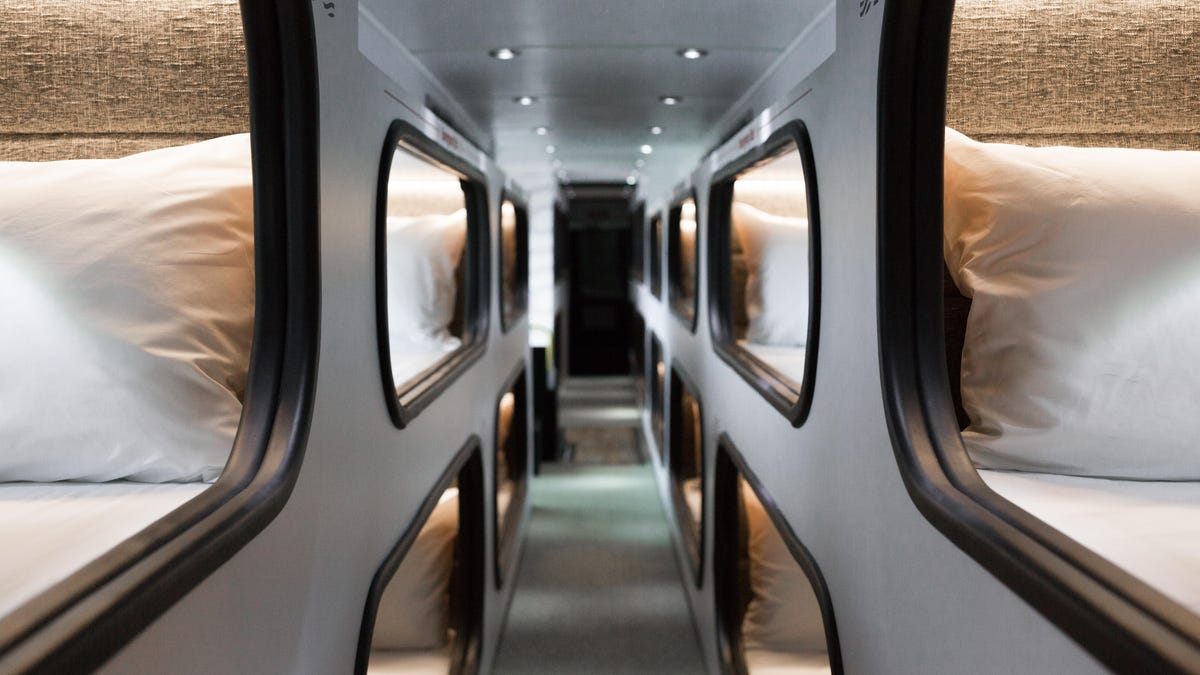Cabin's 'moving hotel' wants to be better than flying
The Cabin sleeper bus will take you between San Francisco and Los Angeles. Let's just hope you can sleep.

The Hyperloop may be the fastest way to travel between San Francisco and Los Angeles, but it's years away from becoming a reality.
In the meantime, the Cabin sleeper bus is an option for those who don't mind a little extra travel time added to their journey. It's a coach with 24 fully flat sleeper pods that transports passengers overnight between SF and LA.
Cabin takes eight hours as drivers intentionally use a slower route to minimize bumps along the way. The same trip normally takes about six hours in a car or just over one hour on a plane (delays not included).
The bus has all the mod-cons you would expect, including Wi-Fi and power outlets in each bunk.
If you're anything like me, you have a lot of questions about a sleeper bus. Here's an edited transcript of my chat with Gaetano Crupi, co-founder and president of Cabin.
And if you want to experience what it's like to sleep on Cabin, watch the video above.
There's no shortage of cheap flights between San Francisco and Los Angeles. So why would you take Cabin that costs $115 one-way?
We didn't design the cheapest way to get to Los Angeles from San Francisco. There's a lot of options that are significantly cheaper. We also didn't design the fastest way. We tried to design the most comfortable way where you don't burn any of your day while being transported.
We are basically an Uber from a downtown location to the airport and we're also a hotel night's stay. So if you add those two endpoints of transportation, the night and the flight, we think $115 is actually a very reasonable price.
Why are you comparing Cabin to a hotel rather than a regular bus?
The reason why we don't use [the term] bus is that people don't want to sleep on a bus. And so everything that we've designed talking about a hotel, from the sheets that we use, the amenities, the pillows, the way our ground crew services the bathroom, the way we steam all of the sheets when we put them on the bed, all of that is really for someone to think of this not as a bus but as another form of transportation.
How does the suspension differ from a regular bus?
It has to be tuned appropriately because suspension has to do a lot with weight. We don't have 80 passengers on this vehicle and really heavy seats, so the weight distribution is a little different. It does take some iteration to understand not only the combinations of different suspension providers that can be installed but how can they be tuned in order for the bus to feel as smooth as possible. We're constantly iterating on almost a week-to-week basis on the suspension right now.
Maybe this will take years, but we want you to feel like on an airplane, where you don't feel any bumps of the road and it just feels like being on a cloud.
What about safety?
Our drivers, their only concern is driving. There's an attendant as part of their team who can deal with everything else. So we really concentrate on having the drivers rested, know the route and also have someone as their co-pilot. In terms of the driver selection process, we also are installing eye scanners, so if there is any fatigue or lane-shifting we can correct that.
The way these cabins are designed is based on sleeper berths in trucks so they have been previously designed for safety. We did think about seat belts and realized that seat belts in the prone position are a little tricky, they might actually be unsafer. For buses, what you really want to optimize is not as much the collision, which is relatively rare, it's anything about [getting] the people off the vehicle. Our optimization is people being able to get out of the Cabin as quickly as possible in case of a fire or some type of incident.
Is an autonomous Cabin a possibility?
Autonomous is basically the holy grail of safety but especially for our vehicles we think that is pretty much a long way. But there are a lot of things that autonomous does in terms of alerting, lane-shifting that we can start populating our vehicle with to give our drivers more information. Systems where you brake or you can't change lanes, alerts to make sure that there is no fatigue on the driver's side.
What other routes are possible in the future?
Where we think the value proposition is even more intriguing is when we start thinking of San Francisco-Santa Barbara, San Francisco-Big Sur, LA-Phoenix, LA-Tahoe. Places that aren't highly trafficked from the air.
I know the pain of the Boston-DC corridor even though it has a train and how expensive it is, so I'm really excited to get to New York as a hub.

